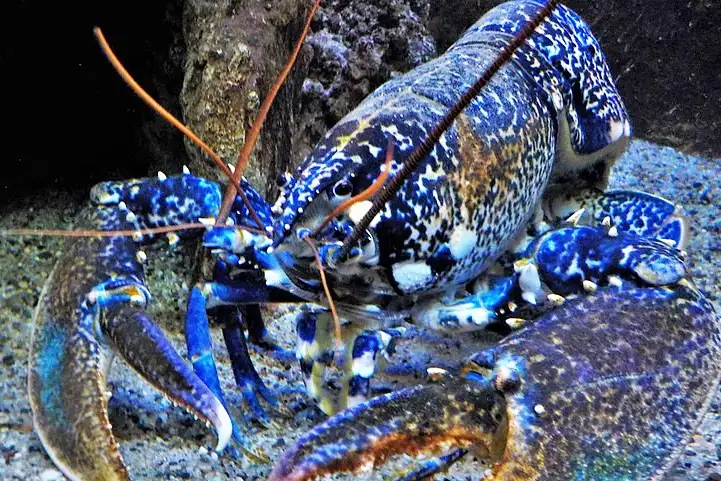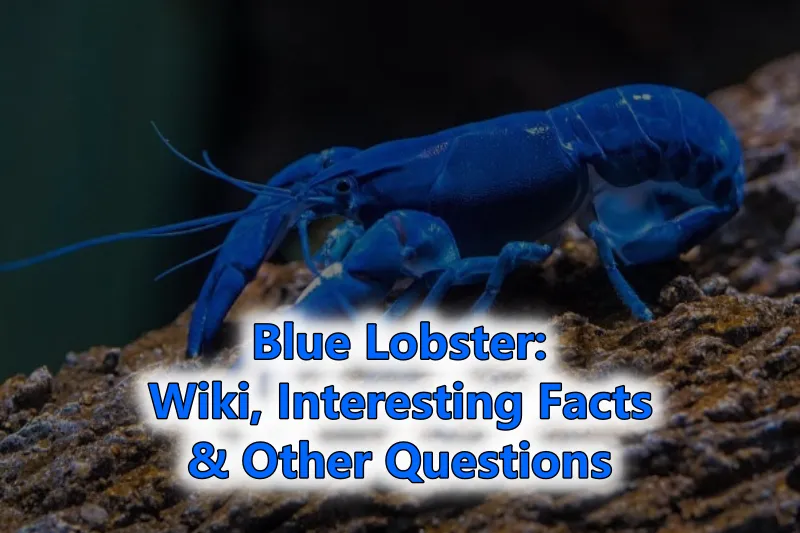Animal lovers find every animal present on the earth unique, it is so as everyone possesses some distinguishable characteristics. Be it a dog or a cat or a bird, or even a fish, every animal has varied lifecycle and diet patterns.
Talking about lobsters— are exotic sea animals. These lobsters are a delicacy in seafood items that are cherished by many. They are also crucial for commercial products that increase their value in every way possible.
These crustaceans are present on this earth in many types— Blue Lobsters, Pearl Lobster, American Lobster, and many more. Each of them is easily distinguishable, and some of them are rare to find.
Specifically, talking about blue lobsters, they are a delight to your eye, the vibrant blue color makes you curious with the black-little spots on the back compliments the pattern in the best way.
Let’s get into this article to know more about the Procambus Alleni, commonly known as blue lobster, and some intriguing facts about this exotic species. Without any further ado, let’s get into the article.
Blue Lobster: Wiki

| Scientific Name | Procambarus Alleni |
| Common Name | Blue Cayfish |
| Size | 2 to 3 inches |
| Habitat | Freshwater marshes, ditches, streams, wetlands, and floodplains |
| Diet | Eat invertebrates, uneaten food, debris, detritus, dead plants, fish flakes, algae wafers, and even dead tank mates. |
| Predators | Sharks, Sea Birds, Octopuses, and Humans |
| Colors | Bright Blue |
| Weight | 24 to 30 ounces |
| Life Span | Up to 5 years |
| Price | As blue lobster is very rare, there price per kilogram varies on the weight. Usually, the weight of the lobster is around $100 to $500 or sometimes even more. |
| About It | The Procambarus Alleni is a tropical water animal, has been giving extravagant looks. It is a solitary nocturnal animal that was born by a genetic defect. The genetic anomaly leads to the beautiful bright blue color in the lobster. |
The blue lobster has already given you a brief overview of the animal; furthermore, the blue lobster is a crazy nocturnal animal, which means they hunt in the dark because they have clear vision that helps them in hunting.
Although it is not the only case, they can also hunt duck and dove. However, sea life is not as easy as it seems. Many predators are moving in the water.
To avoid predators, lobsters hide under rocks or in the rocky crevices of the sea beds. They are easily distinguished from other species because of their bright blue colour, which is due to a genetic anomaly. Also, the particular species was identified by the chemicals present in their bodies.
As we all know about the fishing scenarios in the marine world, most lobsters are caught with nets and spears. However, if targeting any particular area, let’s say Australia, the commercial fishery companies have been incorporating their exceptional services since 1996.
These fisheries rely on the ocean area for the supply of these species sustenance. These species have brought about a drastic change in seafood. Most seafood is available in areas surrounded by the sea or along the coastlines, such as Vietnam, Indonesia, Papua New Guinea, and Australia.
These countries have shown effective aquaculture operations and tremendous growth in fish farming that benefits the single species on an economic level.
8 Interesting Facts About Blue Lobsters:
1) Drizzling Blue Color
One of the craziest things you can encounter on any day is the blue lobster. Rare as a blue moon, these blue lobsters are hard to find. On average, there are chances of catching them in 2 of every 1 million lobsters found in the world.
Although they are rare to find in the world, they are among the most unique creatures. The drizzling blue-shiny color is due to a genetic anomaly that causes its vibrant blue colour.
Chances of being caught by the fishermen are due to the bright color that doesn’t help to blend in the sea causing them to be identified easily.
The lobster institute confirms the chances of coming across a yellow lobster are 1 in 30 million, and sometimes this goes up to a lot more for an albino or a crystal lobster. Isn’t it crazy?
2) Commercial Benefit
Catching a blue lobster will bring money to your pocket, as its charm makes people drool upon tasting it. The blue lobster fetches a high price due to its vibrant blue colour and the beauty of its shell.
The blue cover serves a commercial purpose in making decorative accessories and jewellery. The inner part of the crab is a delight to food lovers.
However, when corruption meets trade, smuggling happens. There have been multiple attempts at smuggling blue lobsters at a high price for their delicacy. They are challenging to breed and feed, which makes them more expensive economically.
3) Aggressive Behavior
Blue lobsters are commendable in every way, be it their appearance or their value in the market. It has been discovered that blue lobsters are quite aggressive, which makes them different from others.
Although it is well known that crabs are aggressive, blue lobsters are at a higher level than regular lobsters.
This catfish has aggression issues due to its inability to blend in with nature and its inability to find suitable partners for breeding. This ratio has caused frustration.
4) Hard Shells for protection
Unlike other lobsters present in the world, blue lobsters are blessed with hard shells, securing them from bloody predators. The potential predators attack the shells, destroy them, and have their tasty meal, thanks to their sturdy shells for securing them.
Many lobster shells are introduced in the making of artefacts, pieces of jewellery, and some decorative pieces. However, it depends upon the sturdiness of the shell.
On average, many shells are discarded every minute during processing if they don’t pass the standards. They are then sent to landfills as it improves calcium and phosphorus levels in the soil. Lobster shells eventually reduce waste and boost profit.
5) Eat their mates
Lobsters were predominantly carrion eaters. Scientists have confirmed that lobsters prefer to eat fish, crabs, mussels, sea urchins, and even other lobsters. They make profitable farming difficult, as lobsters require constant fresh food; if it’s unavailable, they start eating other animals.
6) Feeds with Legs
It is well known that blue lobsters are nocturnal animals; they have poor eyesight, which enhances their sense of smell and taste. For feeding themselves, they couldn’t use their eyes, yet their hairy legs are a rescuer.
The hairs on the legs and feet help them detect the surroundings and the temperature. The presence of tiny antennas helps them locate the food even if there is a huge distance. This is how they feed themselves; nature is truly crazy in every way.
7) Regenerating Limbs Are Seamless
As per studies, it was discovered that lobsters also regrow their limbs. However, this regrowth takes a lot of years to complete. For regrowing a single claw on a one-pound lobster, it takes around five yearser
One such thing that fascinates us is the reflex amputation done by animals when they feel any danger. Claws and walking legs are body parts that can be regrown.
8) Rarest & Most Expensive
Lobsters are among the best sea foods one can ever have in their life. The juicy part makes anyone drool. These tropical lobsters are hard to find, which causes their price to soar. It makes them one of the rarest lobsters in the world.
Blue Lobsters says that blue cayfish can be sold for $100 per kilogramme, which makes them even more expensive than regular American lobsters.
The bright blue colour makes this lobster very rare and beautiful; it is one of the reasons for its being expensive.
Other Facts
- The blue hue in a blue lobster comes from a genetic defect that causes these lobsters to get a vibrant blue color.
- Blue lobsters are so rare that the chance of catching them is one in two million.
- Blue crayfish participate in mating when they reach 1 inch in size. Male lobsters clips off the female’s claw and puts them on her back.
- Blue lobsters are omnivores and usually many bloodworms, mussels, sea urchins, and other lobsters.
Frequently Asked Questions
Q1. How rare is a blue lobster?
Blue catfish are on the list of the rarest animals on earth. The chances of finding them are 1 in 2 million.
Q2. What causes a blue lobster to be blue?
The reason behind the blue color of the lobster is due to the genetic anomaly that causes its vibrant blue color.
Q3. How many blue lobsters are left?
A correct number is difficult to predict as the chances of finding them are rare. So, calculating their presence is harder.
Q4.What is special about blue lobster?
The special thing about a blue lobster is its vibrant blue color which makes them distinguished. These lobsters are blue due to a genetic mutation that causes more production of a particular protein in the body.
Q5. Why blue lobsters are so expensive?
Their appearance of them makes them expensive commercially. When they are caught, and usually put back into the sea.
References:
- Are Blue Lobsters as rare as blue moons? by How Stuff Works
- Wikipedia
- Facts about the blue lobster by akronzoo.org
Also Read:

An engineering student turned into a writer. Expressing thoughts into words is what i prize the most. Being able to conclude my thoughts through my articles is my prime intention. If i am not engaging myself with animal content, you can always find me doing coding. I am an engineer by profession but a writer by heart.
